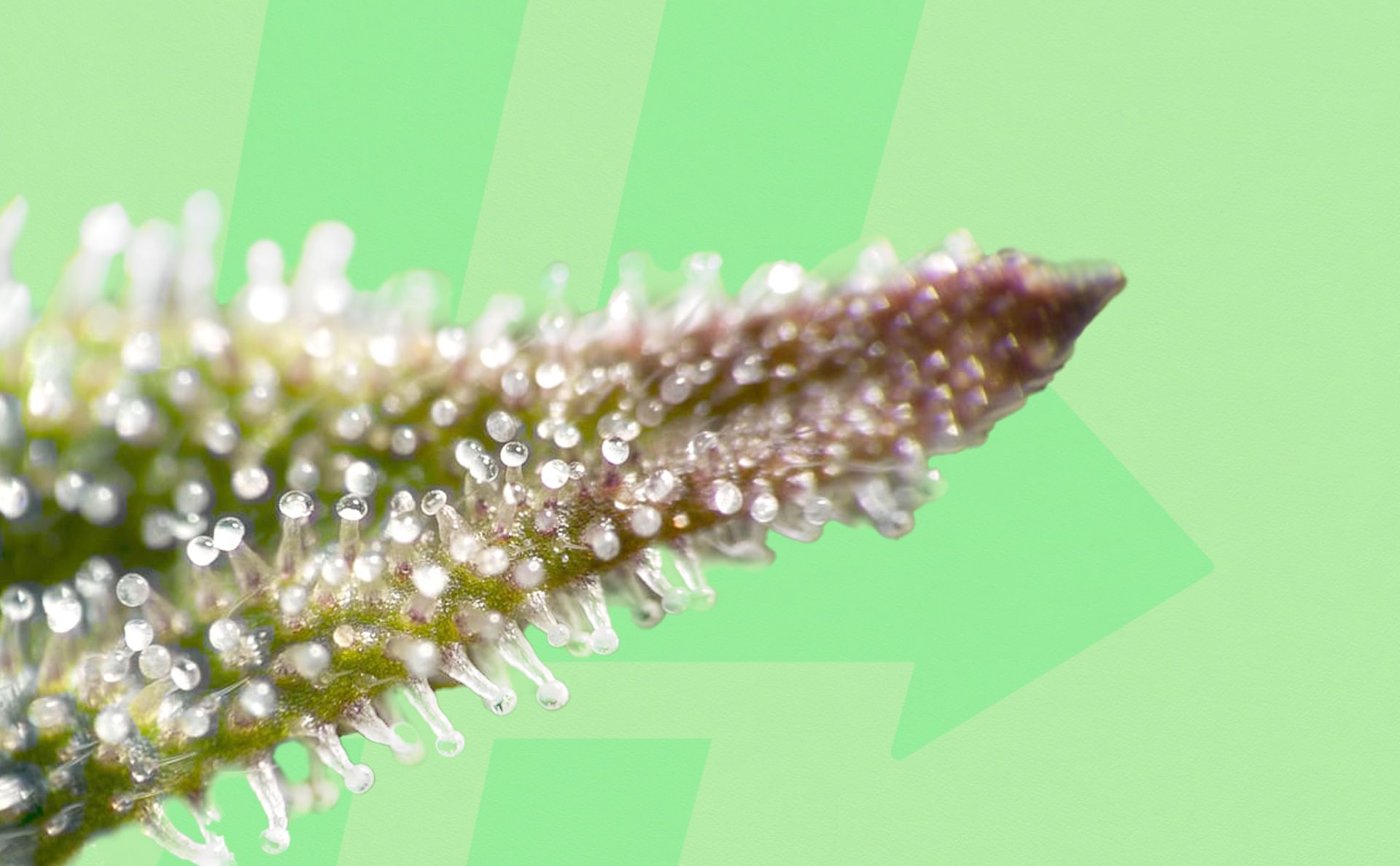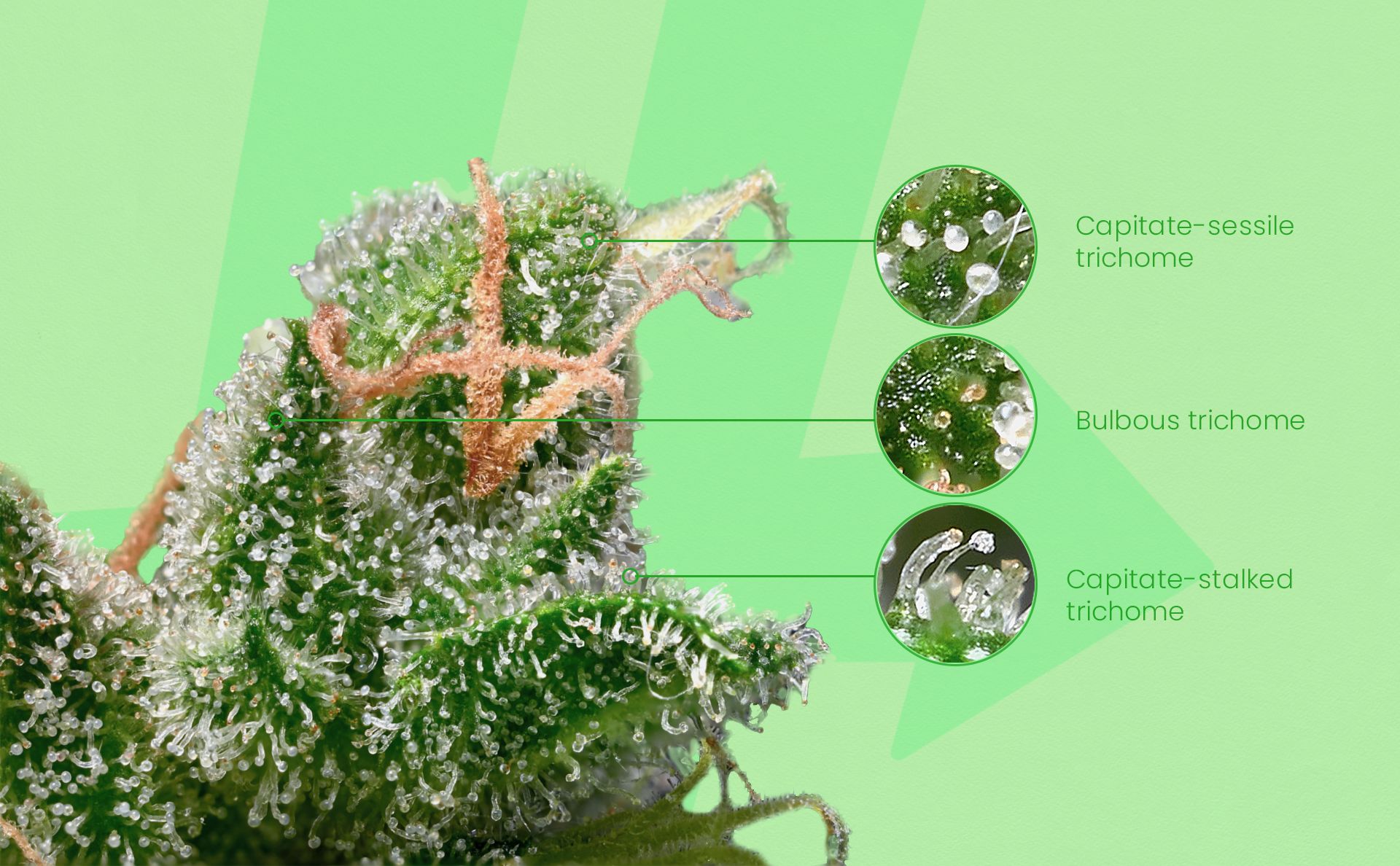Trichomes
When educating yourself about the cannabis plant, a great starting point is to learn all about trichomes. That’s exactly what you’ll do when reading this chapter, where we define trichomes, why they’re the most important part of the cannabis plant, and more.

Even those with an elementary level of understanding about the cannabis plant will know that there is more to it than meets the eye. One of those important parts is trichomes. So what are they, why do they exist, what are the different types of trichomes, and what functions do they serve? Read on for all the interesting details you need to know.
Trichomes Defined
Trichomes are those delicious-looking little hairs or crystals that you see when you take a look at your cannabis flower or leaves. In years past, grinders were not as readily available, so consumers broke up flower by hand. If you fall into this category of old-school cannabis consumer, then you’ve had the sticky, fragrant trichome resinous glands on your fingers afterward.
Also sometimes called frosting or kief, the etymology of the word trichome is the Greek term “Tríchōma,” which translates into ‘growth of hair’. These crystalline hairs cover the leaves and flowers of maturing cannabis plants, remain on the harvested flower, and develop into further deliciousness during the curing process. Trichomes are the most important part of the cannabis plant, containing hundreds of known cannabinoids, as well as terpenes, aromas, and flavors.
Haven’t yet read our Cannabinoids Guide or Terpenes Guide? Be sure to check out our in-depth guides offering a valuable base knowledge of these fascinating and highly useful compounds.
Trichomes hold the key to what makes you love all of your favorite cannabis cultivars. While cannabinoids, flavonoids, and terps do show up all over the plant, trichomes hold the highest concentration of all three and more. This is why trichomes are extracted from cannabis flowers in the process of making concentrates and infusions.
Trichomes Up Close
The shiny, sticky, great-smelling coatings of frost known as trichomes just look like little crystals or hairs to the naked eye. However, put under a microscope, trichomes look like thousands of tiny amber-colored mushrooms.
If you follow any of the talented macro canna photographers on Instagram, you have seen trichomes up close. Down to the molecule, trichomes are a defense mechanism that plants develop to fight off photosynthetic microbes, bacteria, and insects.
Trichomes are one of the last parts of the cannabis plant to mature and are usually a good indicator of harvest time. While they’re growing, they tend to appear to be clear and translucent, but when it’s the best time to harvest, they look opaque or are just starting to turn an amber color.
What is the Function of Trichomes?
As previously mentioned, trichomes on the cannabis plant act as a defense mechanism to ward off predators. These glands can be found in different forms on various plant species in the natural world including algae and various bulbous flowers like orchids. For instance, if you’ve ever seen a carnivorous plant like a venus fly trap, its tiny hair trichomes signal that prey is lurking and that it’s time for dinner.
As female cannabis plants continue through their maturing process in the natural world, they are vulnerable to many different enemies. These include animals, insects, as well as harmful UV rays from the sun. Maturing trichomes are bitter, and render cannabis leaves and flowers unsavory.
This protects the plants from insects and animals that want to eat them. Additionally, trichomes can help shield plants from certain types of fungi as well as protect them from strong winds that can cause damage.
The Life Cycle of Trichomes
As the cannabis plant begins blooming, cannabinoids start to synthesize inside of the trichomes. As it starts to produce its flower, trichomes are formed on the leaves and flower bud surfaces. At this point, cells are forming that will ultimately become cannabinoids.
As is the case with most above-ground plants in our natural world, how quickly a cannabis plant develops trichomes depends on the genetics of the cannabis variety as well as how it’s being grown.
How the plant is grown as well as the impact from the environment affects how much trichomes are concentrated with cannabinoids. Plants with the most trichomes don’t necessarily equate to high cannabinoid and terpene concentrations.
One of the most important factors that impact how trichomes synthesize cannabinoids and terpenes is UV light. Generally speaking, plants that take in the broadest spectrum of light tend to produce higher cannabinoid concentrations. This is also dependent on the specific cultivar as well.
The lifecycle of trichomes is indicative of the lifecycle of the plant they form on. For this reason, keeping a close eye on trichomes is an integral part of growing. Fully formed trichomes indicate that plants might be ready to harvest.
The plant should be ready to harvest when the trichomes appear cloudy and white. While each cultivar is different, and this doesn’t always hold true, the appearance of trichome coloration is a benchmark in determining harvest time for cannabis plants.
Trichomes can act as a defense mechanism on the cannabis plant, but they are also volatile and can be delicate. This is the case whether the cannabis plant is still growing or has been harvested. Trichomes can possibly be damaged or reduced in potency by factors like:
- Too much light or too little
- Excess heat or not enough
- Physical agitation or shaking
- Lack of oxygen or too much
- Too much time on the plant or too little
If trichomes are exposed to the above, they can potentially be damaged. Before harvesting, growers should only touch plants when absolutely necessary. Additionally, when harvested and trimmed for consumption, rubber gloves must be worn to reduce the damage to trichomes.
This is because the oils on the skin of our hands can degrade the trichomes and reduce the potency of cannabinoids or terpenes.
Ultimately, trichomes will degrade over time, but proper care can slow this process down a lot. In addition to proper trimming, careful techniques of drying and curing will also help to preserve trichomes.
Extracting trichomes by making concentrates like kief, hash oil, wax, and so on will prolong the shelf life and the cannabinoids inside of them. Storing your flower in glass containers instead of plastic can also help slow down the degradation process. Light and heat are the top two enemies of harvested cannabis, so store your buds in a cool, dark place.
Different Types of Cannabis Trichomes
Trichomes come in three main types. Although each of these three resinous glands is different in size and shape, they all produce cannabinoids and terpenes. The three different types of trichomes found on the cannabis plant are:
- Bulbous trichomes
- Capitate-Sessile trichomes
- Capitate-Stalked trichomes

Bulbous Trichomes
These types of glands are the smallest of all three. Bulbous trichomes are almost not visible to the naked eye, and they also tend to be the most scarce. Most staminate and pistillate plants contain bulbous trichomes.
Capitate-Sessile Trichomes
The word capitate comes from the Latin capitātus, meaning ‘head of’ or ‘stem’. Your capitate bone is found in the center of your carpal bone region, which we more commonly call a wrist. In botany, capitate means forming or shaping like a head or dense cluster.
In cannabis, trichomes that are capitate-sessile are medium-sized parts of the plant and denser than their bulbous counterparts. The cells of these trichomes secrete cannabinoids that accumulate on the outer membrane.
Capitate-Stalked Trichomes
The largest in size of all three main types of cannabis trichomes, capitate-stalked glands contain the highest concentration of cannabinoids and terpenes. These are the trichomes that growers tend to look for the most when determining if it is harvest time.
Trichomes: Results May Vary
Even though cannabis plants or flower are covered in a thick layer of frosty trichomes doesn’t mean it will result in the desired effect, flavor, or potential benefit. Just as all consumers are different, so are cannabis plants.
Each variety of cannabis is different: from the seed to the way the plant was grown, when it was harvested and how long ago, how the flower was cured, and so on. While the appearance of trichomes on cannabis flower is a good indication of high quality, it’s not a foregone conclusion.
Go Forth and Try Some Trichomes
Trichomes and consumers are never one-size-fits-all, and that’s one of the best things about cannabis. Exploring how colors, textures, and shapes of various trichomes found on an intact plant translate into consuming its flower is a part of the cannabis consumption experience. Now that you see those frosty-covered, tasty-looking flower buds at a dispensary, you’ll know all about trichomes.
What We Learned: Trichomes
There’s a lot to learn about trichomes, but this chapter offers an excellent primer. Here are some key takeaways we learned about these fascinating parts of the cannabis plant:
- The term trichome comes from the Greek word “Tríchōma,” meaning ‘growth of hair’.
- Trichomes are crystalline hairs that cover the flowers and leaves of mature cannabis plants.
- Trichome glands serve as defense mechanisms in various plant species in the natural world including, algae, venus fly traps, and certain types of flowers.
- Trichomes are the most important part of the cannabis plant, containing essential compounds like terpenes and cannabinoids.
- Put under a microscope, trichomes look like tiny amber-colored mushrooms.
- Trichomes indicate harvest time and unhealthy trichomes or damaged trichomes often lead to low-quality products.
- Extracting trichomes by making concentrates like kief, hash oil, wax, and so on also will prolong the shelf life and the cannabinoids inside of them.
- Storing your flower in glass containers instead of plastic can also help slow down the degradation process. Light and heat are the top two enemies of harvested cannabis, so store your buds in a cool, dark place.
Reading up on trichomes is important for newer growers and consumers, and we would argue that it’s essential. Many expert growers say that the best way to learn about this plant is to grow it yourself. Answer the question below, and then in the next chapter of this guide, you will learn about just that: Growing Cannabis at Home.
Citations
- National Library of Medicine: Cannabis Glandular Trichomeshttps://www.ncbi.nlm.nih.gov/pmc/articles/PMC8488169/
- Analytical Cannabis: The Science of Cannabis Trichomeshttps://www.analyticalcannabis.com/articles/the-science-of-cannabis-trichomes-313105
Test your knowledge, track your progress and earn your badge.
Which type of trichome is the smallest?